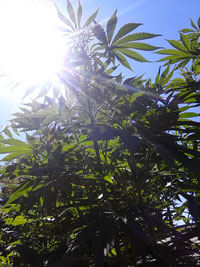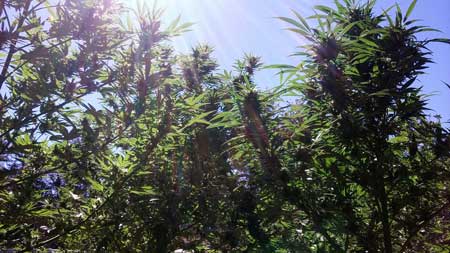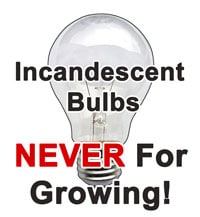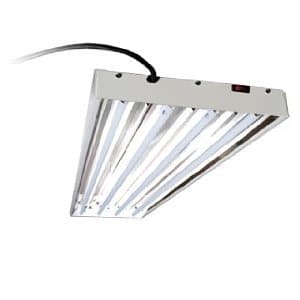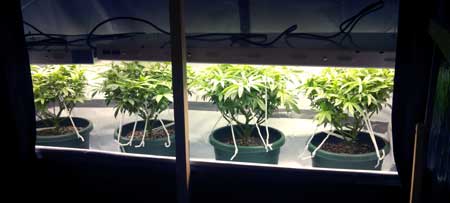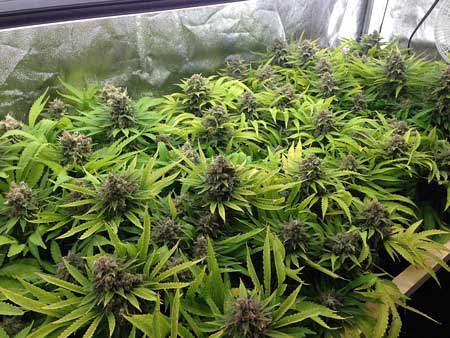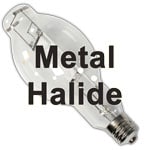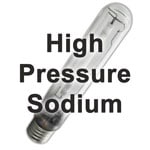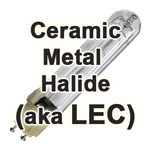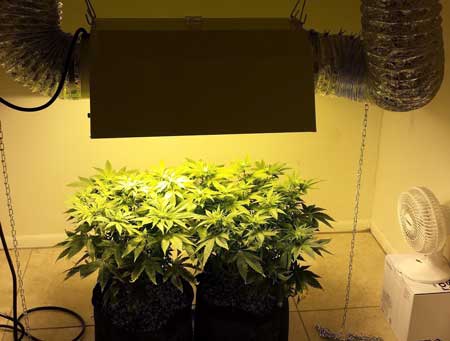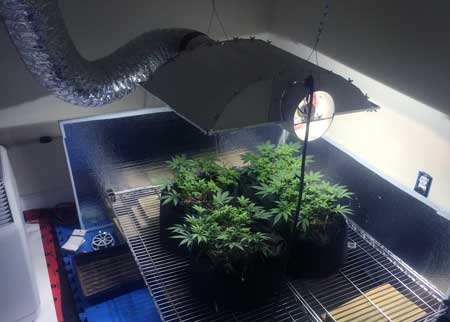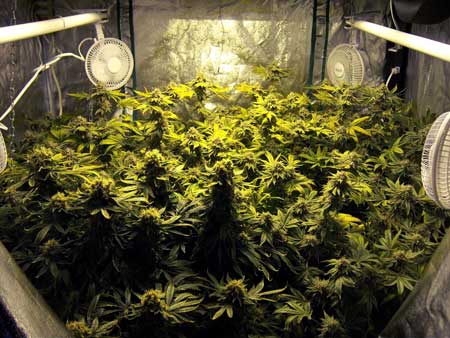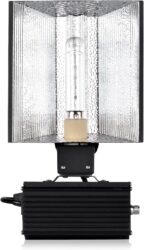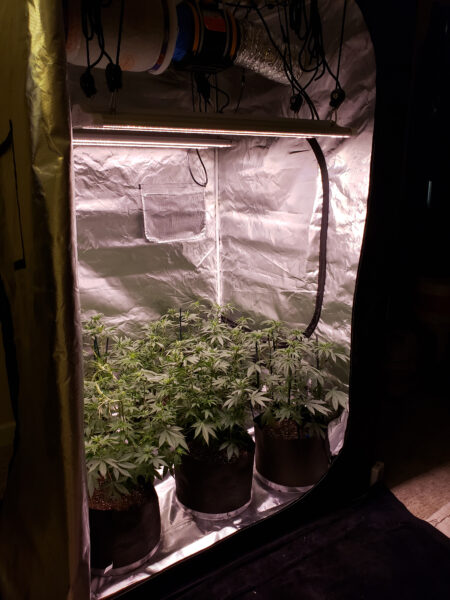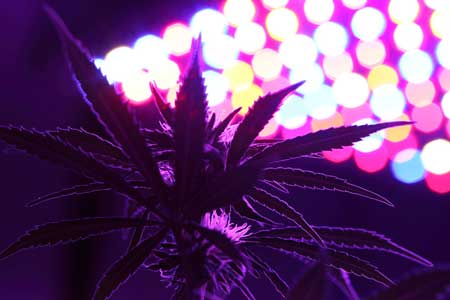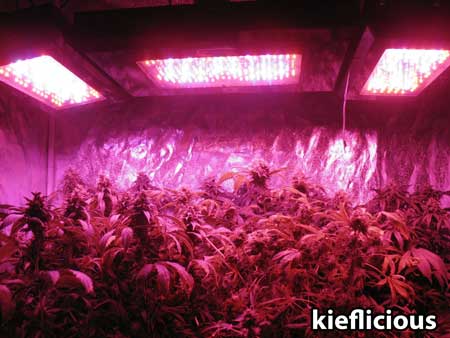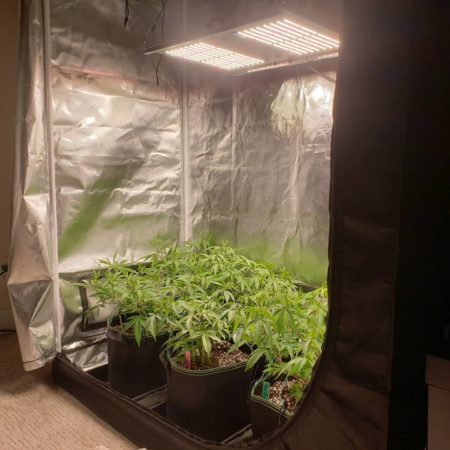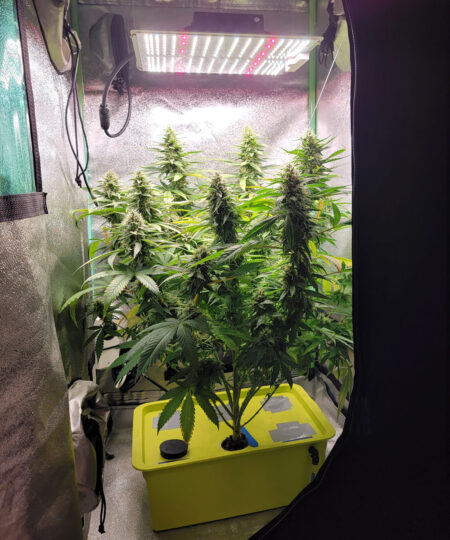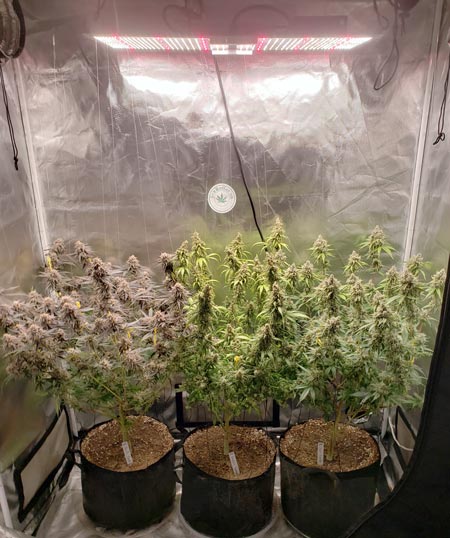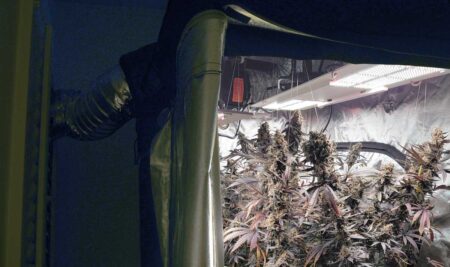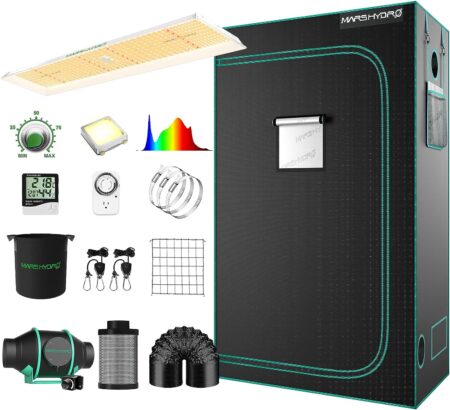by Nebula Haze
For the many growers who are unable to cultivate cannabis outside in the free abundant sunshine, grow lights are necessary to successfully grow cannabis indoors. Grow lights take the place of the sun, and power the growth of your plants and their buds. Light is like “food” for your plants, so without a lot of bright light, even a healthy cannabis plant won’t produce much bud at all.
More Light = Bigger Yields!
(up to a point, it is possible to give your plant too much light!)
3 Main Classes of Marijuana Grow Lights
There are lots of options for grow lights that work well for growing cannabis indoors but in the end they boil down to 3 major types:
2.) High Intensity Discharge (HID) Grow Lights
3.) LED Grow Lights
- LEDs come in a huge variety of sizes and form factors.
- When it comes to growing weed, some LEDs get much better yields and bud quality than others.
Note: Some growers may have heard of “Induction” or “plasma” grow lights, which are pretty rare these days but still pop up from time to time. There are two types: “Magnetic Induction” grow lights do okay for growing cannabis but they’re pretty much glorified fluorescent lights. “Plasma Induction” grow lights actually perform pretty poorly at growing cannabis.
Some types of induction lights are well suited to stadium lighting but they just aren’t that great for growing cannabis and they come with huge price tags. Most LEDs are cheaper and you’ll get far better results with them. You can learn more about induction grow lights here.
Note 2: Incandescent light bulbs (old-fashioned light bulbs) are NOT suitable for growing marijuana!
Compare the Pros and Cons of Each Grow Light
Fluorescent grow lights come in many different shapes and sizes, from twisty bulbs to long tubes. Fluorescents are popular because they make efficient and pleasant lighting for humans, and also work great for herb gardens and other types of low-key indoor gardening without using a lot of electricity.
Read the full tutorial on T5 grow lights.
T5 grow lights are one of the most easily available types of grow lights and are used to grow many different types of plants. As a result, they’re available in many garden and home improvement stores.
T5s are much bigger/wider than a regular light bulb and usually come as part of a panel. They can often be kept mere inches away from your plants without worrying about burning them because they produce relatively weak light levels.
Note: I’ve noticed some companies are produced “T5” grow lights that are actually LED grow lights, just in the shape of a fluorescent T5. Here’s an example of a “T5 LED” grow light. These can be used pretty much the same as a fluorescent T5 grow light, however, just like old-fashioned T5s, the LED versions are typically underpowered for growing weed.
These vegetative cannabis plants are thriving under T5 grow lights. However, buds tend to stay small if you use a T5 in the flowering stage while buds are forming.
Learn more about T5 grow lights for growing cannabis.
Pros of Fluorescents
- Cheap to buy
- They don’t use a lot of electricity or make a lot of heat unless you have a lot of them packed together in a small space
- Good light spectrum for growing cannabis
- One of the best lights for clones, seedlings and young plants, as they tend to be gentle. Big lights must be kept far away from young plants to avoid burning them, which ends up wasting a lot of light and energy. By using smaller lights like fluorescents while plants are still short, you can save quite a bit of money on electricity during those first few weeks compared to using a high-powered grow light.
Cannabis plants flowering under a T5 grow light – when plants are trained (like these ones in a Scrog setup) you can get okay yields from fluorescents. However, the yields-per-watt and the bud quality tends to be lower compared to using more powerful grow lights while buds are forming.
Cons of Fluorescents
- Fluorescent grow lights get much smaller yields per watt than the other types of grow lights if you use them in the flowering stage while buds are forming. With fluorescents you can expect about 0.25 grams of buds for every watt of electricity (using the true watts out the wall, not any type of “equivalent” watts), while LEDs and HPS get 2-4 times as much yield per watt of electricity.
- The light from a fluorescent lamp doesn’t penetrate far down into the plant so they are best suited to plants that have been trained to grow short and flat; they aren’t powerful enough to support tall plants in the flowering stage.
Summary: Fluorescents are a great choice for clones, young plants, supplemental lighting and can save you money on electricity in the vegetative stage compared to using high power lights when plants are too young to use it all anyway. However, after cannabis plants have moved past their first week or two, you will get much faster growth from more intense grow lights like HIDs or LEDs.
Learn more about T5 grow lights for growing weed.
2.) High Intensity Discharge (HID) Grow Lights
HID grow lights are much more efficient than fluorescent lights and are powered by large, oddly-shaped bulbs. They are usually screwed into a reflector or hood to reflect more light down onto the plants. HIDs are great at growing cannabis, but they also get very hot and are usually hooked up to an exhaust to help vent out heat.
Check out the full tutorial on MH & HPS grow lights.
MH and HPS grow lights get hot. They’re great for growing cannabis in a cool grow space, and one of the cheapest ways to start growing big yields.
Check out the full tutorial on CMH / LEC grow lights.
LEC stands for “Light Emitting Ceramic” and is a type of Metal Halide bulb that is built with ceramic like an HPS. Basically it’s sort of like a blend between MH and HPS bulbs. These got really popular around 2018-2020 but have fallen out of favor since then. The biggest benefit of using LECs is they dramatically increase trichome production (“sparkle”) on buds, which makes them a good choice for growers making concentrates by extracting the trichomes.
Metal Halide grow lights are generally used for the vegetative stage because they produce a bluish light that vegetative plants love. MH tends to keep plants relatively short compared to other types of grow light. Although this type of light can also be used all the way to harvest, it tends to have reduced yields and reduced bud potency compared to switching to an HPS bulb once buds start forming.
The light from a Metal Halide appears a little bluish, and is well suited to growing cannabis plants in the vegetative stage.
Learn more about MH grow lights.
High Pressure Sodium (HPS) Grow Lights
High Pressure Sodium grow lights are often used during the flowering stage because they are very efficient and their yellow light stimulates bud production. HPS grow lights in the flowering stage get better yields per watt of electricity than any other type of grow light available today, which is a big part of why they are so popular.
The light from an HPS appears yellow, and is great for flowering plants because the light spectrum stimulates bud production
Learn more about HPS Grow Lights
Ceramic Metal Halide (CMH) & Light Emitting Ceramic (LEC) Grow Lights
These are actually just two names for the same thing. This type of metal halide bulb uses ceramic as part of the lamp just like an HPS. As a result, CMH bulbs are more efficient than regular MH lights (though still not as efficient as HPS bulbs).
“LEC” and “CMH” both refer to Ceramic Metal Halide grow lights, which is a type of HID light that is a bit more efficient than a regular Metal Halide light.
Learn more about CMH / LEC grow lights
Pros and Cons of HID Grow Lights
Pros
- Efficient – HIDs are an extremely efficient type of grow light (gets very high yields per watt and produces excellent bud density).
- Best HID for Yields – Of all the HIDs, HPS grow lights are the most efficient and the best for the flowering stage when it comes to yields. When using HPS grow lights in the flowering stage, you can expect up to 1 gram/watt if all goes well.
- Simple – HID lights are simple to use because they can be hung the right distance from the plants with no guesswork on your part (unlike LEDs), and no need to adjust the lights all the time (like fluorescents).
- Cheap Setup – HID grow lights give you one of the cheapest setups to get great yields. For example, a 600W HPS grow light can produce a pound or more and a complete 600W grow light kit only costs about $100-150. Check below for more information.
Cons
- HID bulbs get really hot and generate a lot of heat. Because of the concentrated heat production, you will almost always want to put the bulb in a hood and also provide some sort of cooling to prevent heat from beaming down onto your plants and driving up the ambient temperature of your tent/grow room. This is especially important for the bigger lights with power above 250W.
- Additional setup – As a result of the heat mentioned above, most growers use an exhaust fan with ducting to vent out heat. Unfortunately, the prospect of having to deal with the fan and ducting scares off many growers from HID lighting.
- More parts – HID lighting means a few more parts than other types of lighting. Fluorescents are just the bulb and a fixture and most LEDs are just the light itself. But most HID setups have at least a bulb, fixture, an external ballast and an extra cable if you don’t count the exhaust systems parts, too.
Example of MH/HPS Setups with Expected Yields
- 1.5 – 3.5 oz per month
- Electricity: $96/month (including electricity for fans)
- Initial Setup Cost: $744.00
- 2.5 – 5 oz per month
- Electricity: $128/month (including electricity for fans)
- Initial Setup Cost: $780.00
There is a larger size MH/HPS grow light available (1000W), but at that size it starts going outside the scope of a “hobbyist” grower as far as ease and yields. In addition to needing a lot of extra cooling which costs electricity, a 1000W HPS grow light is less efficient compared to a 600W grow light (as far as how much light is put out for electricity used). I think most hobbyist growers would be happier with a 600W, or even two 600W lights, over a 1000W 🙂
HIDs are very well suited to growing cannabis and very easy to use once they’re set up. If your main goal is to get the highest yields possible, then HIDs are the way to go! However, they do require extra setup compared to the other grow lights because chances are you will need a fan to vent out heat from your grow space.
Learn more about MH / HPS grow lights.
Learn more about CMH / LEC grow lights.
LED grow lights are very popular among cannabis growers as an alternative to HPS grow lights. They tend to run cooler and also usually come with built-in cooling that tends to move heat up and away from the fixture instead of beaming it down onto your cannabis plants like a bulb would. LEDs can be plugged directly into a wall and hung over plants. This is easier than setting up an HID grow light which needs you to screw in the bulbs and hang the fixture, possibly using ducting to vent heat. LEDs also have great penetration so they don’t need to be moved frequently like fluorescents.
Simply hang an LED light over your plants and start growing!
Check out my list of the Best LEDs for Growing Weed in 2024.
Learn more about growing cannabis with LED grow lights.
You might be interested: HPS vs LEDs: LED grow lights finally won.
Avoid “Blurple” LED grow lights (they’re old technology)
Old fashioned LED grow lights were this “blurple” color, almost like a black light, but these aren’t as effective at growing weed as wider-spectrum modern LEDs.
“Blurple” color LEDs are old technology. They tend to get worse yields and bud quality than modern wide-spectrum LEDs that appear with a more white light.
Modern LEDs have wide-spectrum light
Modern LEDs are “wide-spectrum” or “full-spectrum” and their light appears white, bluish, or pinkish. You should see the natural color of all the leaves.
The best LED grow lights to use in the flowering (budding) stage usually have a pinkish-white light because they have a lot of LEDs in the red spectrum.
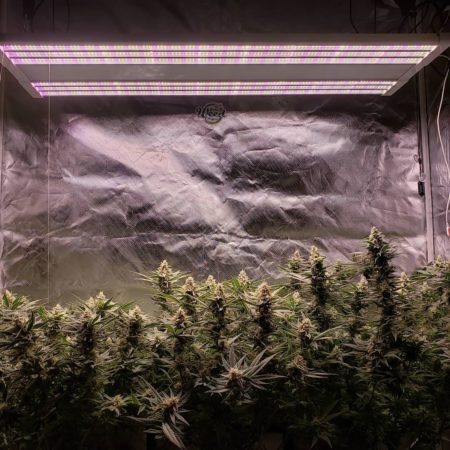
LEDs come in all sizes, which means they can be used even in small grow spaces to get great yields and bud quality.
A small-yet-effective LED grow light like this Spider Farmer SF2000 is an excellent choice for beginner growers in a 2’x4′ grow tent. Check out my full review of the SF-2000 LED for growing cannabis.
Pros and Cons of LED grow lights
Pros
- Less Heat – LEDs almost always have built-in cooling that pushes heat up and away from the plants (unlike HID bulbs which beam heat down on your plants and need to be cooled separately). LEDs are also more electrically efficient than HID or fluorescent grow lights. As a result, LEDs run very cool. On top of that, cannabis plants actually prefer warmer temperatures with LEDs. All in all, for smaller sizes, cannabis growers may be able to get away without venting heat at all.
- Easy to Hang – The smaller size LEDs can be plugged directly into the wall and hung up over your plant, without needing to do anything else. You can just plug them in and start growing!
- Bud Quality – In side-by-side tests, we’ve found good LEDs seem to increase the THC percentages vs using HPS grow lights. Some growers believe LEDs produce more resinous bud. LEDs also tend to bring out pretty colors on buds like pinks and purples.
Cons
- Still Some Heat – Although the LED lamp itself usually does run a lot cooler than a similar wattage HPS bulb, they still produce heat and the bigger sizes like 300W+ may need to be vented with an exhaust fan to prevent the grow space from getting too warm.
- Learning Curve – LEDs get slightly smaller yields per watt than HPS grow lights, on average, at least on the first grow, and especially for first-time LED growers. Growers need to “dial it in” and “get the hang” of using their LED grow light model. Since every LED grow light is different, they don’t have a standard distance away from plants like HID grow lights, which are standardized into specific sizes and form factors. There is a learning curve when it comes to getting the best yields from your LEDs. A little experience with a specific lamp can improve your yields by a lot!
- Avoid Older Models – Newer LED grow lights (especially since 2021 and later) get significantly better yields than older ones. There have been major improvements in LED tech since 2020, and many growers will find they get much better results simply from upgrading to a newer LED from a trustworthy company.
- Extra Distance to Plants – Small LEDs can be kept very close (my 100W LED is great at 8-12″ away) but big LED grow lights (above 400-500W or so) have strong lenses pointed down, and therefore tend to need a lot of space between the lamp and your plants compared to HPS grow lights. That means you need a tall grow space to get the best results with big LEDs. As an example, 300W LED panels should be kept 18-24″ away during the second half of the flowering stage to avoid light burning your buds (buds can be burned from too much light even if the temperature is cool), and some of the bigger models need to be kept 30″ or more away from the buds. That compares to a 600W HPS which can be under 18″ away as long as it’s cool. When in doubt, contact the LED manufacturer!
If you get very high-wattage LEDs, you may need to vent out heat to keep the grow space cool.
Notice that this grow tent vents out a window. This makes it much easier to keep a room cool if you’ve got big grow lights.
For growers who are looking to harvest up to 10 ounces per harvest, about 200-300W of LEDs may be your best choice. At this size, they are super low on electricity, run cool and need almost no setup. They get better yields than fluorescents but don’t run as hot as an HPS of similar wattage.
One great choice in this size is the Mars Hydro SP3000 which uses more electricity but gets significantly bigger yields. Here’s a complete 300W LED grow tent kit from Mars Hydro with everything you need that’s a great deal at $550 for the tent, light, carbon filter, fan, and accessories.
Note: When shopping for LEDs, make sure they contain some amount of green or white (full spectrum) light. Plants grown without at least a tiny amount of green or white light are very prone to nutrient deficiencies and simply don’t grow as well. Learn more about how light spectrums affect cannabis growth!
Learn more about growing cannabis with LED grow lights.
You might be interested: 5 Barriers to Total LED Grow Light Domination!
Now that you are familiar with all the most common cannabis grow lights I hope your choice is a little easier. I wish I’d had this information when I first started growing indoors 🙂 Happy growing!!!
~Nebula Haze
